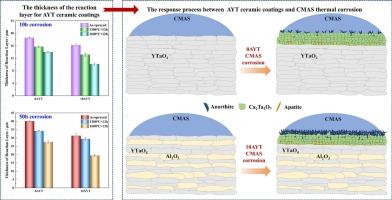Investigation of the CMAS thermal corrosion resistance of novel Al2O3/YTaO4 thermal barrier coatings
IF 5.3
2区 材料科学
Q1 MATERIALS SCIENCE, COATINGS & FILMS
引用次数: 0
Abstract
In this paper, atmospheric plasma spraying was used to produce YTaO4 thermal barrier coatings and 10 wt% Al2O3-YTaO4 thermal barrier coatings. The coatings were heated to temperatures of 1300 °C and 1600 °C, respectively. The corrosion resistance and mechanism of the coatings against CMAS corrosion at 1250 °C for 10 h and 50 h were then investigated. This study revealed that during CMAS thermal corrosion, the primary corrosion products were anorthite, apatite, and Ca2Ta2O7. Apatite and Ca2Ta2O7 formed a compact layer at the boundary between the reaction layer and the coating layer, effectively blocking CMAS melt infiltration in a downward direction. As the heated temperature increased, the volume expansion resulting from the phase transformation and the closure of pores and microcracks within the coating caused the coated surface to become denser. The corrosion rate of the coatings was reduced due to a reduction in grain boundaries and a lower concentration of defects in the grain boundary regions. This improved the resistance of coatings to CMAS thermal corrosion. The presence of Al2O3 facilitated the formation of anorthite in the CMAS melt. Excessive anorthite can form a thick network that hinders the penetration of the CMAS melt. Meanwhile, it increased the viscosity of the melt and reduced its ability to spread, resulting in a slower rate of penetration by the CMAS melt. This, in turn, improved the coatings' ability to withstand thermal corrosion caused by CMAS.

新型 Al2O3/YTaO4 隔热涂层的 CMAS 耐热腐蚀性能研究
本文采用大气等离子喷涂技术生产 YTaO4 隔热涂层和 10 wt% Al2O3-YTaO4 隔热涂层。涂层的加热温度分别为 1300 ℃ 和 1600 ℃。然后研究了涂层在 1250 °C 下 10 小时和 50 小时的抗 CMAS 腐蚀性及其机理。研究发现,在 CMAS 热腐蚀过程中,主要的腐蚀产物是阳起石、磷灰石和 Ca2Ta2O7。磷灰石和 Ca2Ta2O7 在反应层和涂层之间的边界形成了一层致密层,有效阻止了 CMAS 熔体向下渗透。随着加热温度的升高,相变产生的体积膨胀以及涂层内部孔隙和微裂缝的闭合导致涂层表面变得更加致密。由于晶界的减少和晶界区域缺陷浓度的降低,涂层的腐蚀速率也随之降低。这提高了涂层对 CMAS 热腐蚀的耐受性。Al2O3 的存在促进了 CMAS 熔体中阳起石的形成。过多的阳起石会形成厚厚的网络,阻碍 CMAS 熔体的渗透。同时,它还会增加熔体的粘度,降低其扩散能力,导致 CMAS 熔体的渗透速度减慢。这反过来又提高了涂层抵御 CMAS 热腐蚀的能力。
本文章由计算机程序翻译,如有差异,请以英文原文为准。
求助全文
约1分钟内获得全文
求助全文
来源期刊

Surface & Coatings Technology
工程技术-材料科学:膜
CiteScore
10.00
自引率
11.10%
发文量
921
审稿时长
19 days
期刊介绍:
Surface and Coatings Technology is an international archival journal publishing scientific papers on significant developments in surface and interface engineering to modify and improve the surface properties of materials for protection in demanding contact conditions or aggressive environments, or for enhanced functional performance. Contributions range from original scientific articles concerned with fundamental and applied aspects of research or direct applications of metallic, inorganic, organic and composite coatings, to invited reviews of current technology in specific areas. Papers submitted to this journal are expected to be in line with the following aspects in processes, and properties/performance:
A. Processes: Physical and chemical vapour deposition techniques, thermal and plasma spraying, surface modification by directed energy techniques such as ion, electron and laser beams, thermo-chemical treatment, wet chemical and electrochemical processes such as plating, sol-gel coating, anodization, plasma electrolytic oxidation, etc., but excluding painting.
B. Properties/performance: friction performance, wear resistance (e.g., abrasion, erosion, fretting, etc), corrosion and oxidation resistance, thermal protection, diffusion resistance, hydrophilicity/hydrophobicity, and properties relevant to smart materials behaviour and enhanced multifunctional performance for environmental, energy and medical applications, but excluding device aspects.
 求助内容:
求助内容: 应助结果提醒方式:
应助结果提醒方式:


